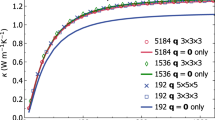Abstract
The relationship for the static conductivity has been derived from the basic principles of fluctuation statistics. This relationship is non-Arrhenius at low temperatures and describes the experimental data with a high accuracy. Reasoning from general considerations, it is demonstrated that neither the “connectivity scheme” nor the Monte Carlo computer models, which predict the purely Arrhenius behavior of the static conductivity in vitreous solid electrolytes at low temperatures, can serve as the basis for the correct description of ion transfer in similar systems.
Similar content being viewed by others
References
Kincs, J. and Martin, S.W., Non-Arrhenius Conductivity in Glass: Mobility and Conductivity Saturation Effects,Phys. Rev. Lett, 1996, vol. 76, no. 1, pp. 70–73.
Ngai, K.L. and Rizos, A.K., Parameterless Explanation of the Non-Arrhenius Conductivity in Glassy Fast Ionic Conductors,Phys. Rev. Lett, 1996, vol. 76, no. 8, pp. 1296–1299.
Maass, P., Meyer, M., Bunde, A. and Dieterich, W., Microscopic Explanation of the Non-Arrhenius Conductivity in Glassy Fast Ionic Conductors,Phys. Rev. Lett, 1996, vol. 77, no. 8, pp. 1528–1531.
Tatsumisago, M., Saito, T. and Minami, T., Low Temperature Behavior of Frozen α-AgI in Rapidly Quenched Glass Matrices,Solid State Ionics, 1994, vols. 70-71, pp. 394–397.
Inaguma, Y., Chen Liquan, Itoh, M. and Nakamura, T., Candidate Compounds with Perovskite Structure for High Lithium Ionic Conductivity,Solid State Ionics, 1994, vols. 70-71, pp. 196–202.
Angell, C.A., Mobile Ions in Amorphous Solids,Ann. Rev. Phys. Chem., 1992, vol. 43, pp. 693–717.
Bässler, H., Schönherr, G., Abkowitz, M. and Pai, D.M., Hopping Transport in Prototypical Organic Glasses,Phys. Rev. B: Condens. Matter, 1982, vol. 26, no. 6, pp. 3105–3113.
Bondarev, V.N. and Zhukov, V.M., On the Theory of Cationic Substitution in Ionic Conductors,Fiz. Tverd. Tela (Leningrad), 1991, vol. 33, no. 3, pp. 846–853.
Bondarev, V.N. and Pikhitsa, P.V., “Universal” Frequency Response of Disordered Conductors and Related Problems: A Novel Approach,Phys. Lett. A, 1994, vol. 196, pp. 247–252.
Bondarev, V.N. and Pikhitsa, P.V., Fluctuation Theory of Relaxation Phenomena in Disordered Conductors: How Fitting Laws Such as Those of Kohlrausch and Jonscher Are Obtained from a Consistent Approach,Phys. Rev. B: Condens. Matter, 1996, vol. 54, no. 6, pp. 3932–3945.
Bässler, H., Localized States and Electronic Transport in Single Component Organic Solids with Diagonal Disorder,Phys. Status Solidi B, 1981, vol. 107, no. 1, pp. 9–54.
Maass, P. and Meyer, M., Conductivity versus Spin-Lattice Relaxation: Contrasting Behavior in a Correlated Disordered Structure,J. Chem. Phys., 1995, vol. 103, no. 13, pp. 5776–5780.
Palmer, R.G., Stein, D.L., Abrahams, E., and Anderson, P.W., Models of Hierarchically Constrained Dynamics for Glassy Relaxation,Phys. Rev. Lett, 1984, vol. 53, no. 10, pp. 958–961.
Binder, K. and Young, A.P., Spin Glasses: Experimental Facts, Theoretical Concepts, and Open Questions,Rev. Mod. Phys., 1986, vol. 58, no. 4, pp. 801–976.
Sher, H. and Lax, M., Stochastic Transport in a Disordered Solid: I. Theory, II. Impurity Conduction,Phys. Rev, B: Solid State, 1973, vol. 7, no. 10, pp. 4491–4519.
Carini, G., Cutroni, M., Federico, M., Galli, G., and Tripodo, G., Acoustic Properties and Diffusion in Superionic Glasses,Phys. Rev. B: Condens. Matter, 1984, vol. 30, no. 12, pp. 7219–7224.
Jonscher, A.K.,Dielectric Relaxation in Solids, London: Chelsea Dielectric, 1983.
Al’tshuler, B.L., Kravtsov, V.E. and Lerner, I.V., Relaxation Time Spectrum in Disordered Conductors,Pis’ma Zh. Eksp. Teor. Fiz., 1987, vol. 45, no. 3, pp. 160–163.
Kob, W. and Barrat, J.-L., Aging in a Lennard-Jones Glass,PhysicaA (Amsterdam), 1999, vol. 263, pp. 234–241.
Almond, D.P., Duncan, J.K. and West, A.R., Analysis of Conductivity Prefactors and Ion Hopping Rates in Agl-Ag2MoO4 Glass,J. Non-Cryst. Solids, 1985, vol. 74, pp. 285–301.
Kawamura, J. and Shimoji, M., Ionic Conductivity and Glass Transition in Superionic Conducting Glasses (AgI)1-x(Ag20O4), (x = 0.25, 0.30, 0.35): I. Experimental Results in the Liquid and Glassy States, II. Structural Relaxation and Excess-Free Volume Theory,J. Non-Cryst. Solids, 1986, vol. 88, nos. 2–3, pp. 281–294;295–310.
Author information
Authors and Affiliations
Rights and permissions
About this article
Cite this article
Bondarev, V.N., Pikhitsa, P.V. The theory of non-arrhenius conductivity in vitreous solid electrolytes. Glass Phys Chem 26, 377–382 (2000). https://doi.org/10.1007/BF02732003
Issue Date:
DOI: https://doi.org/10.1007/BF02732003




